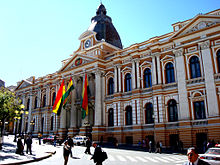Bolivian Politics
Bolivian politics is oriented by means of a unitary State with autonomies: The Plurinational State of Bolivia, organized according to the Political Constitution. In 2016, Bolivia was the second country in Latin America with the highest representation of women in parliament. They represented 51% of the deputies and 44% of the senators.
History
The civil war between the conservatives and the liberals ended in 1899 with the victory of the latter; a liberal era began that lasted until 1920. A system of public education developed, accompanied by moderate anti-clericalism: Catholicism lost its status as the only state-recognized religion in 1906 and civil marriage was adopted in 1911. Bolivian liberalism, however, it clearly lost its progressive character in order to coexist with the interests of the new tin fortunes (the liberal era is also seen as the tin age, with a considerable increase in tin production), landlords, and the military. Inspired by the example of the liberal revolution led by Eloy Alfaro in Ecuador, a new liberalism will organize itself in a republican party and will express some social concerns against the domination of the liberal oligarchy.
Status
Bolivia is mainly composed of the President of the State (Executive Branch) who acts in coordination with the Ministries of State, the Plurinational Legislative Assembly (Legislative Branch) and the different courts that exercise the (Judicial Branch).
Its electoral system consists of universal and compulsory suffrage, with the age of majority at 18 years.
Legislative Body
Bicameral Plurinational Legislative Assembly, chaired by the Vice President of State.
- House of Senators: 36 members elected by direct universal suffrage for a five-year term. Four senators are elected by department.
- Chamber of Deputies: 130 seats elected by direct universal suffrage for a four-year term; 62 elected in the 9 departmental constituencies by proportional system (D'hondt) and 68 in single-mining constituencies (small than departments) by simple majority.
The legislators of both Chambers (senators and elected representatives) representing the same department or region, jointly make up the Departmental Parliamentary Brigades, organized to coordinate actions of regional interest.
Judicial Branch
The Judicial Branch is made up of four fundamental bodies, according to the new Political Constitution of the State of 2009. Something significant about this new constitution is that each of the members of the entities that make up the Body Judiciary are elected by the popular vote of all citizens, Bolivia is the only country in the world that elects members of the Judiciary in this way.
The Supreme Court of Justice, the highest court of justice in the State in ordinary, contentious and contentious-administrative matters. It is made up of nine Senior Magistrates or Magistrates who will make up the Plenary Chamber and nine Substitute Magistrates or Magistrates. The Magistrates last in office for six years and cannot be re-elected. The Tribunal is based in Sucre. The District Courts in each Department capital have investigative judges in civil, commercial, criminal, controlled substances, family, child labor and social security, mining and administrative matters.
The Plurinational Constitutional Court, an independent body subject only to the Constitution, with headquarters in the city of Sucre, is made up of five magistrates that make up a single chamber. They hold office for a period of six years and cannot be re-elected.
Among its main attributions is that of hearing in a single instance matters of pure law on the unconstitutionality of laws, conflicts of jurisdiction between public powers and between autonomous levels, direct appeals for annulment and review of appeals constitutional protection and habeas corpus.
The Judicial Council is the administrative and disciplinary body of the Judiciary. It is headquartered in the city of Sucre.
The Agri-environmental Court, which is the highest specialized court of agri-environmental jurisdiction. It is governed in particular by the principles of social function, integrality, immediacy, sustainability and interculturality.
There is also an Indigenous Native Peasant Jurisdiction, which establishes the capacity of the Indigenous Peoples of Bolivia to exercise justice according to their uses and customs.
Electoral Body
This body is considered a State power in the New CPE of Bolivia of 2009. It is made up of:
- The Supreme Electoral Court, as the highest instance.
- The Departmental Electoral Tribunals, as a departmental instance.
- The Electoral Courts.
- The Jury of the Suffrage Tables.
- The Electoral Notaries.
Participation in international organizations
United Nations
- UN
- UNCTAD
- FAO
- ILO
- ECLAC
- Unesco
- WHO
- IMO
- IFAD
- UNIDO
- IOM
- IAEA
- ICAO
- UTI
- WIPO
- WMO
- WTO
- MONUC
Financial and commercial institutions
- IMF
- WTO
- IDB
- BIRF
- AIF
- CFI
- ISO (current)
Others
- Mercosur (in the process of incorporation)
- OAS
- G-77
- IATA
- Interpol
- ALADI
- FISCR
- MPNA
- OPANAL
- OPCW
- CPA
- UPU
- OMA

